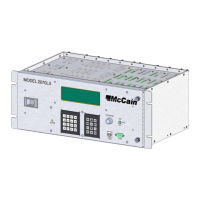2070LX Controller – User Manual 23
Version 1.0
This converter consists of two current mode synchronous buck regulator controllers operating 180° out of
phase with each other at a normal switching frequency of 375 kHz. Out of phase operation reduces the
input RMS ripple current, thereby significantly reducing the required input capacitance.
The two switching regulator outputs are independently adjusted:
One regulator is adjusted to 1.8VDC @ 7A for providing power to the DDR2 memory.
The other regulator is adjusted to 3.3VDC @ 4A in order to provide power for almost all circuitry on
Engine Board: Boot EEPROM, SRAM and FLASH memories, CPU, uP supervisory circuit, RTC, USB
transceiver, buffer, drivers, transceivers, transparent latches, logic gates, Linesync & ACFail control
circuit, CPULRESET line circuit, etc; except the two Ethernet transceivers.
Over-voltage protection is available for both outputs. Its current-mode feedback control assures excellent
line and load regulation and wide loop bandwidth for excellent response to fast load transients. It also
features analog soft-start circuitry that is independent of the output load and output capacitance making
the soft-start behavior more predictable and controllable.
Power Interruption, Power Restoration and Synchronization signals
POWERDOWN
This is a +5VDC input signal to the Engine Board. During normal operation it is at high state; During AC
power failures it goes to low state; if it is a short power outage, there is no reset and the application
software continues operating normally. If it is a long power outage then a reset is performed.
POWERUP
It is a +5VDC input signal to the Engine Board. During normal operation it is at high state; during a long
power outage it drives to low state causing all software execution to be halted, once power is restored a
cold restart is performed.
LINESYNC
The LINESYNC signal is a +5VDC signal input to the Engine Board. It provides a 50% duty cycle square-
wave at 60Hz and it is used provide a periodic interrupt to the Processor as a clock reference.
Miscellaneous signals
CPU_ACTIVE
This is an active-low, +5VDC output signal provided to indicate an active CPU and is accessible to
application programs. The typical use for this signal is to drive a front-panel’s 'ACTIVE' LED.
DKEY_PRESENT
This is an active-low, +5VDC input signal to the Engine Board. When this signal is active, it indicates the
physical presence of a secured key in the DataKey receptacle.
ENGINE_PRESENT
This is an active-low output signal from the Engine Board; it is physically connected to logic ground. It
indicates the physical presence of an Engine Board to the Host Board.
EQUIPMENT GROUND
The Equipment Ground is routed from Host Board to Engine Board through a mounting hole located near
to pin 50 at P1 connector.

